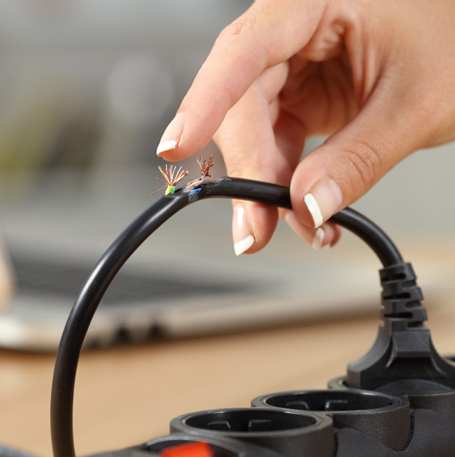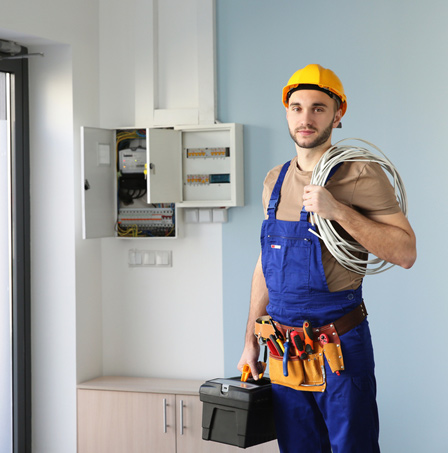What’s an EICR?
Electrical Installation Condition Reports (EICRs) are official
documents provided by engineers or electricians after
conducting electrical inspections on residential and
business properties. The assessment is based on the quality
of the building’s electrical installations.
Details of EICR include:

Fire
20,000 fires happen in the UK every years.
Appliances
89% caused by electrical products.
Wires
11% due to faulty wirings.

What’s an EICR?
Electrical Installation Condition Reports (EICRs) are official
documents provided by engineers or electricians after
conducting electrical inspections on residential and
business properties. The assessment is based on the quality
of the building’s electrical installations.
Details of EICR include:
In the UK, up to seven fire incidents in a day can be attributed to
faulty wires.
EICRs have five main purposes:


In the UK, up to seven fire incidents in a day can be attributed to
faulty wires.
EICRs have five main purposes:
In an inspection, the electrician checks the following:
Any electrical installation that fails to pass the test must be replaced or repaired immediately to comply with safety standards.
The inspector may classify problematic installations either as Code C1, Code C2 or Code C3.

Examples of Code C1 include exposed live wires that are accessible to human touch and conductive parts that have become exposed.
Examples of Code C2 include the absence or a reliable earthing, and when a metallic pipe is used for flammable
liquids like gases.
Examples of Code C3 include the absence of a 'Safety Electrical Connection - Do Not Remove' sign, and socket
outlets mounted incorrectly.

In an inspection, the electrician checks the following:
Any electrical installation that fails to pass the test must be replaced or repaired immediately to comply with safety standards.
The inspector may classify problematic installations either as Code C1, Code C2 or Code C3.
Examples of Code C1 include exposed live wires that are accessible to human touch and conductive parts that have become exposed.
Examples of Code C2 include the absence or a reliable earthing, and when a metallic pipe is used for flammable
liquids like gases.
Examples of Code C3 include the absence of a 'Safety Electrical Connection - Do Not Remove' sign, and socket
outlets mounted incorrectly.
WHY DOES MY PROPERTY NEED AN EICR?
Conducting a regular EICR gives you several benefits, such as:
Insurance
Several insurance companies request that you have your electrical systems tested regularly. Should you need to claim for damages from a possible electrical fault, you need to substantiate that you took the necessary steps to ensure electrical safety, including an EICR Certificate of Safety. Check your insurance policy to learn if an EICR is one of your insurer’s requirements.
Compliance with regulations
Having an updated EICR shows that you are aware of your responsibilities as a building owner or landlord as stated in laws such as:
Legal Protection
An EICR is proof that you took the necessary measures to ensure the safety of everyone in the property. In case an electric fire or shock causes injury or damage to an occupant, you can use the EICR to show that you didn’t neglect your duty as a landlord or business owner, saving you costly legal and damage fees.
SAFETY
Regularly testing your electrical system provides peace of mind that the property is safe for you, customers and staff since there is a reduced risk of damage and injury from electrical fire and shock.
Energy efficiency
Aside from confirming that your electrical system is safe, an EICR also draws your attention to areas of improvement, reducing your energy consumption and improving your carbon footprint.
Cost-effectiveness
Reducing your energy consumption means your business saves money. Identifying electrical faults also means correcting them before they cause costly damage.
The electrician will determine how frequent an EICR should be
performed. For example, the standard inspection for a rental
property should take place every five years, but the electrician can
recommend inspection every three years if the electrics are old.
In general, inspection should be done every:

A periodic inspection must be carried out when selling a previously owned house, or if the property is a house in multiple occupation (HMO).

The electrician will determine how frequent an EICR should be
performed. For example, the standard inspection for a rental
property should take place every five years, but the electrician can
recommend inspection every three years if the electrics are old.
In general, inspection should be done every:
A periodic inspection must be carried out when selling a previously owned house, or if the property is a house in multiple occupation (HMO).
The law requires landlords to ensure their electrical installations
are checked by a qualified person every five years.
Likewise, it is their responsibility to maintain the integrity of the
installations throughout the tenant's stay
New regulations from the Electrical Safety Standards in the Private
Rented Sector state:
Failure to comply with regulations can cost fees of up to £30,000


The law requires landlords to ensure their electrical installations
are checked by a qualified person every five years.
Likewise, it is their responsibility to maintain the integrity of the
installations throughout the tenant's stay
New regulations from the Electrical Safety Standards in the Private
Rented Sector state:
Failure to comply with regulations can cost fees of up to £30,000
Trust Prop Cert with electrical wires and cables
At Prop Cert, we have dedicated, accredited inspectors who handle your EICR requirements with unfailing efficiency and professionalism.
As part of our 5-star service, ease and convenience is something we proudly offer clients. Placing an order via our portal takes less than a minute. Once placed, the order gets assigned to our local electrician, who will make contact with the client within 24 hours.
An appointment will be booked within one to three days. Once the order is confirmed, the client will receive an email confirmation.
We have a bespoke order management system that allows clients to track their progress. Reach out to our experts NOW and get your electrical installations checked.
WHAT HAPPENS IF I DON’T PASS THE EICR?
If your EICR report reveals issues with your electrical system, the results will come out as “Unsatisfactory,” meaning there is remedial work to be done. The electrician will also provide a fixed price quotation for the remedial work. The electrician will indicate a code to specify the extent of the risk and the required actions:
C1
CODE 1
Danger present. Risk of injury.
C2
CODE 2
Potentially dangerous.
C3
CODE 3
Improvement recommended.
FI
FURTHER INVESTIGATION
Further checks required without delay.
EICR TESTING BY ENERGY PERFORMANCE CERTIFICATES
Whether you are a landlord or a building owner, you want to make sure that all electric installations and equipment are safe for use with minimal risk of electric fire and shock. Keep your investment and tenants safe by having your electrical systems undergo an EICR test. At Energy Performance Certificates, we are committed to providing low-cost, high-quality EICR assessments to give peace of mind to you and your occupants. Here’s what makes us the choice contractor of many clients across the UK:
Largest provider of property certificates in the country
We have inspected and tested a wide variety of residential and commercial properties all over the UK, inspecting over 5,000 properties a month. No property is too big or too small for our services.
Trust Worthiness
Our high score at TrustPilot makes us the choice contractor by over 78,000 clients. We hire local electricians who have the necessary certifications to carry out EICR inspections.
Comprehensive Resting
All our EICR inspections are conducted by a fully qualified inspector, all approved components fully tested with approved equipment, an approved certificate and a free remedial quote.
Fast Turnaround
We conduct tests in the evening, during the holidays or your preferred schedule to minimise any downtime for your business. Our electricians conduct the test in a quick yet thorough manner so you can get back to your daily activities.
Excellent Customer Services
Our EICR tests are conducted by qualified electricians and engineers who use the best equipment to assess every area of your property. They also provide professional advice on how you can maintain the safety of your electrical systems.
Low Prices
You won’t find the same quality of service at a lower price. We take pride in providing transparent pricing and we do not charge hidden or extra costs.